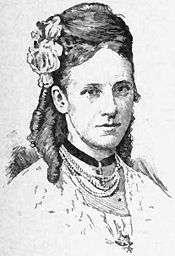Mary von Waldersee
| Mary von Waldersee | |
|---|---|
|
Mary von Waldersee | |
| Born |
Mary Esther Lee 3 October 1837 Germany |
| Died | 4 July 1914 (aged 76) |
| Occupation | philanthropist |
| Spouse(s) | Frederick of Schleswig |
| Signature | |
|
| |
Countess Mary von Waldersee (3 October 1837 – 4 July 1914), born Mary Esther Lee, was an American-born philanthropist in Germany. She was married in turn to Prince Frederick of Schleswig-Holstein-Sonderburg-Augustenburg-Noër and Count Alfred von Waldersee, the successor of Field-Marshal von Moltke.
Mary von Waldersee was the youngest daughter of David Lee, a New York merchant, and Anne Duryce Phillips Lee.[1] David Lee left his widow and five children a large fortune and they moved to Europe in January 1853. The second daughter, Blanche, married Augustus Charles Murray, a commander in the British navy, and the third, Josephine (1833, New York City – 1930, Stuttgart), married Baron August von Waechter, ambassador of the king of Württemberg to the court of Napoleon III. The baroness sent for her youngest sister, Mary, to live with her in Paris, where she met and married Prince Frederick of Schleswig-Holstein-Sonderburg-Augustenburg-Noër, son of Princess Louise Auguste of Denmark, who had been driven into exile by the Austro-Prussian army in 1864. Miss Lee, however, not wishing to enter into a morganatic marriage, induced the prince to renounce his rights and titles as a member of the royal house of Denmark.[2] He subsequently accepted from the Emperor of Austria the title of Prince of Noër, from the name of his principal estate.[3] The prince died shortly after his marriage while on honeymoon to the Holy Land, 2 July 1865, and the princess then returned to Paris, where she resided with her sister, the Baroness Waechter, until the beginning of the Franco-Prussian War, when she accompanied the latter to Württemberg.
On 14 April 1874 she married Count von Waldersee. Countess von Waldersee was particularly close to her first husband's niece, who became the Empress of Germany, Augusta Victoria and this close relationship also came to include Wilhelm II, who was a frequent guest of the Waldersees in Berlin.[4] The relationship may have developed into a physical one, according to Alson J. Smith in "A View of the Spree" after the Waldersees moved to Berlin.[5] There she soon became widely known through her political salon and her interest in local charities. While she resided in Berlin, she was equally zealous in good works. For some years she worked with the antisemitic Reverend Adolph Stoecker, Director of the Berlin City Mission. The Reverend Dwight L. Moody invited him to speak at the 1893 Chicago World Fair, but had to rescind the invitation because of Stoecker's antisemitism.[6] Though Countess von Waldersee may not have been aware of Stoecker's antisemitism, she did help him obtain a court chaplaincy in 1874.[7] She was for years the friend of Emperor Frederick William of Germany and of Empress Victoria, until the women fell out over the direction in which Germany should move. Empress Victoria envisioned an English-style constitutional monarchy, while Countess von Waldersee wanted "...the crown to rest on the head of a pious and socially concerned Christian ruler, but one who was also a politically conservative Pan-German nationalist in the Prussian rather than the English tradition."[8]
References
- ↑ Crowning Glory. American Wives of Princes and Dukes. Richard J. Hutto. Henchard Press, Macon, Ga., 2007, 136
- ↑ Crowning Glory, 137
- ↑ Crowning Glory, 137
- ↑ View of the Spree. Alson J. Smith. The John Day Company, New York, 1962, 79
- ↑ View of the Spree, 82
- ↑ View of the Spree, 60
- ↑ View of the Spree, 62
- ↑ View of the Spree, 86
Bibliography
-
 Wilson, James Grant; Fiske, John, eds. (1889). "Waldersee, Mary". Appletons' Cyclopædia of American Biography. New York: D. Appleton. This source gives the date of her marriage to von Waldersee as 1871; the English and German articles on Alfred von Waldersee give the date as 1874.
Wilson, James Grant; Fiske, John, eds. (1889). "Waldersee, Mary". Appletons' Cyclopædia of American Biography. New York: D. Appleton. This source gives the date of her marriage to von Waldersee as 1871; the English and German articles on Alfred von Waldersee give the date as 1874. - August von Wächter (in German)
- "Crowning Glory. American Wives of Princes and Dukes" by Richard Jay Hutto, Henchard Press, Macon, Ga., 2007
- "A View of the Spree" by Alson J. Smith,Publisher:John Day Company, New York, 1962
- "The extraordinary career of the American grocer's daughter who became a "sanctified Pompadour" to Germany's last Kaiser.
